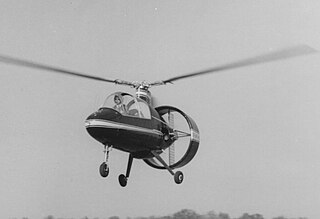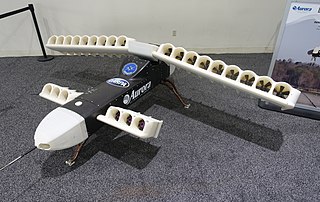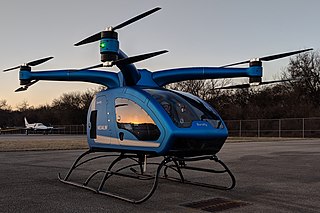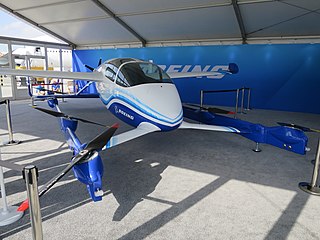A vertical take-off and landing (VTOL) aircraft is one that can take off and land vertically without relying on a runway. This classification can include a variety of types of aircraft including helicopters as well as thrust-vectoring fixed-wing aircraft and other hybrid aircraft with powered rotors such as cyclogyros/cyclocopters and gyrodynes.

A rotorcraft or rotary-wing aircraft is a heavier-than-air aircraft with rotary wings or rotor blades, which generate lift by rotating around a vertical mast. Several rotor blades mounted on a single mast are referred to as a rotor. The International Civil Aviation Organization (ICAO) defines a rotorcraft as "supported in flight by the reactions of the air on one or more rotors".

An electric aircraft is an aircraft powered by electricity. Electric aircraft are seen as a way to reduce the environmental effects of aviation, providing zero emissions and quieter flights. Electricity may be supplied by a variety of methods, the most common being batteries. Most have electric motors driving propellers or turbines.

The Carter PAV is a two-bladed, compound autogyro developed by Carter Aviation Technologies to demonstrate slowed rotor technology. The design has an unpowered rotor mounted on top of the fuselage, wings like a conventional fixed-wing aircraft mounted underneath, and a controllable pitch pusher propeller at the rear of the fuselage. Heavy weights are placed in the rotor tips to enhance rotational energy and to reduce flapping.

Aurora Flight Sciences is an American aviation and aeronautics research subsidiary of Boeing which primarily specializes in the design and construction of special-purpose Unmanned aerial vehicles. Aurora has been established for 20+ years and their headquarters is at the Manassas Regional Airport in Manassas, Virginia.

The Aerial Reconfigurable Embedded System (ARES) was a concept for an unmanned VTOL flight module that can transport various payloads. The concept started as the TX (Transformer) in 2009 for a terrain-independent transportation system centered on a ground vehicle that could be configured into a VTOL air vehicle and carry four troops. ARES' primary function was the same as TX, to use flight to avoid ground-based transportation threats like ambushes and IEDs for units that don't have helicopters for those missions. It was to be powered by twin tilting ducted fans and have its own power system, fuel, digital flight controls, and remote command-and-control interfaces. The flight module would have different detachable mission modules for specific purposes including cargo delivery, CASEVAC, and ISR. Up to 3,000 lb (1,400 kg) of payload would be carried by a module.

The Avian 2/180 Gyroplane was a two-seat, single-engine autogyro built in Canada in the 1960s. Several prototypes were built but production was not achieved.

The Vertical Take-Off and Landing Experimental Aircraft program is an American research project sponsored by the Defense Advanced Research Projects Agency (DARPA). The goal of the program is to demonstrate a VTOL aircraft design that can take off vertically and efficiently hover, while flying faster than conventional rotorcraft. There have been many previous attempts, most of them unsuccessful.
Guangzhou EHang Intelligent Technology Co. Ltd is a company based in Guangzhou, China that develops and manufactures autonomous aerial vehicles (AAVs) and passenger AAVs which have entered service in China for aerial cinematography, photography, emergency response, and survey missions.
Urban Air Mobility (UAM) is the use of small, highly automated aircraft to carry passengers or cargo at lower altitudes in urban and suburban areas which have been developed in response to traffic congestion. It usually refers to existing and emerging technologies such as traditional helicopters, vertical-takeoff-and-landing aircraft (VTOL), electrically propelled, vertical-takeoff-and-landing aircraft (eVTOL), and unmanned aerial vehicles (UAVs). These aircraft are characterized by the use of multiple electric-powered rotors or fans for lift and propulsion, along with fly-by-wire systems to control them. Inventors have explored urban air mobility concepts since the early days of powered flight. However, advances in materials, computerized flight controls, batteries and electric motors improved innovation and designs beginning in the late 2010s. Most UAM proponents envision that the aircraft will be owned and operated by professional operators, as with taxis, rather than by private individuals.

The Lilium Jet is a prototype German electric vertical take-off and landing (eVTOL) electrically powered airplane designed by Lilium GmbH. A seven-seat production version is planned.

The Aurora XV-24 LightningStrike is an experimental unmanned aerial vehicle created by Aurora Flight Sciences and partners Rolls-Royce and Honeywell. It was developed for the Vertical Take-Off and Landing Experimental Aircraft program.

The Volocopter 2X is a German two-seat, optionally-piloted, multirotor eVTOL aircraft. The personal air vehicle was designed and produced by Volocopter GmbH of Bruchsal, and first introduced at the AERO Friedrichshafen airshow in 2017. The aircraft is sold complete and ready-to-fly. Volocopter was formerly known as E-volo.

The SureFly is a two-seat hybrid eVTOL aircraft designed by American truck-manufacturer Workhorse Group, before the program was bought by Moog Inc. for $5 million in December 2019.

The Boeing Passenger Air Vehicle (PAV) is an American electrical powered autonomous personal air vehicle prototype developed by the Boeing NeXt division of Boeing with the assistance of Aurora Flight Sciences.
The Boeing Cargo Air Vehicle is an unmanned, autonomously flying, fully electric cargo air vehicle (CAV). It was made possible by an investment of Boeing HorizonX Ventures.

The Sabrewing Rhaegal is a proposed American unmanned cargo aircraft developed by Californian Sabrewing Aircraft.

The VoltAero Cassio is a family of hybrid electric aircraft being developed by startup company VoltAero. The company plans to produce three configurations of the Cassio aircraft: the four-place Cassio 330, the six-place Cassio 480, and the ten-place Cassio 600.
An electric vertical take-off and landing (eVTOL) aircraft is a variety of VTOL aircraft that uses electric power to hover, take off, and land vertically. This technology came about thanks to major advances in electric propulsion and the emerging need for new aerial vehicles for urban air mobility that can enable greener and quieter flights. Electric and hybrid propulsion systems (EHPS) have also the potential of lowering the operating costs of aircraft.
The Pipistrel Nuuva V300 is an unmanned hybrid-electric VTOL cargo aircraft currently under development by Pipistrel and projected to be released in 2023. The aircraft has eight electric motors driving propellers providing lift as well as a single internal combustion engine driving a propeller providing thrust. The company claims that the aircraft will be able to operate with a typical cargo weight of 300 kg (661 lb) and a typical range of 300 km (162 nmi). In October 2020 the company announced that the aircraft would implement a Honeywell fly-by-wire system.














